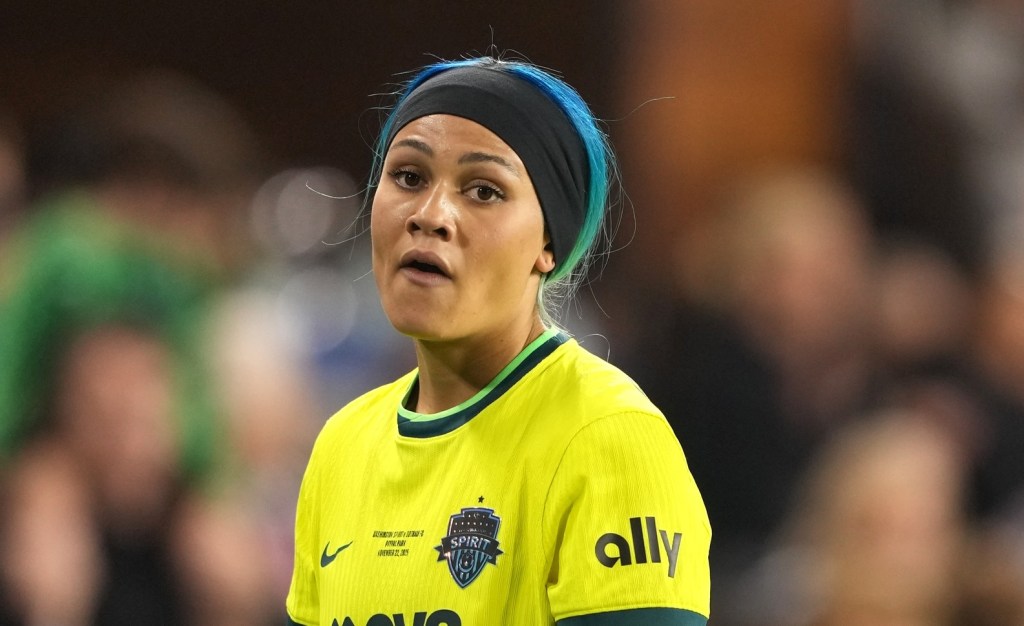Suffering the residual effects of a concussion, UFC middleweight Ian Heinisch reached out to the lead developer of a cryptocurrency meme coin that launched a month ago.
The ask: money to cover a $25,000 stem cell procedure in Mexico.
“I wasn’t able to afford the stem cell treatment,” Heinisch told Front Office Sports. “I hadn’t fought in a year. I had to pull out of a fight against Sam Alvey [in February].”
The man who developed the Marshall Rogan Inu (MRI) — a digital asset that lives on the blockchain in the same way as entrenched crypto currencies like bitcoin and ethereum — told FOS that it took three minutes for the leaders of the coin to approve the treatment, which isn’t legal in the U.S. There’s nothing illegal about the coin, although crypto and legal experts told FOS that how it’s been marketed has mirrored some other “pump-and-dump” digital assets — and that should give investors pause.
But there’s no doubt plenty of funds have flowed to fighters. Heinisch is among the most prominent of the 200 fighters whom the developer said have received more than $800,000 since the coin was minted in February.
That sum is equal to the combined purses of 20 of 26 fighters at UFC 272, minus bonuses paid out by UFC for the Las Vegas event. Not bad for a coin created as somewhat of a lark that morphed into an answer to the debate over fighters’ pay, according to backers of MRI.
“It is almost impractical for these fighters to be able to live comfortably and support their families,” organizers behind the coin wrote. “We find this to be very important because as it currently stands, these fighters are not earning a livable wage and often must choose between pursuing their dreams or getting a job just to live.”
The crypto community has long been enamored with meme coins like Dogecoin — inspired by then-ubiquitous memes around a Shiba Inu dog — which has been the most highly traded of the sort since its arrival in 2013. MRI is among many of the dog-inspired derivative meme coins that go for pennies or less.
These types of coins are typically relegated to smaller exchanges, although Doge and some others are traded on more mainstream marketplaces like Crypto.com and FTX. MRI organizers admit that to get on the larger exchanges they will have to “self doxx,” meaning they’d reveal their identities in a move that would reassure the crypto market as a whole, along with officials at the mainstream exchanges.
The developer and another MRI official spoke to FOS on condition of anonymity.
MRI has no affiliation with UFC, although it was hard to tell at UFC 272 on Saturday, when headliner Colby Covington was among six fighters to mention MRI in post-fight interviews. Each was paid thousands for mentioning MRI, and two fighters received $25,000 each in bonuses.
While UFC declined comment, an MMA source with knowledge of the situation told FOS that the promotion is aware of MRI and officials have done some preliminary research into the coin.
MRI doesn’t have an association with longtime UFC commentator and podcaster Joe Rogan, whose dog, Marshall, is depicted in cartoon form on the coin.
Regulators Ramping Up
In an executive order on Wednesday, President Joe Biden outlined a “whole-of-government approach” that calls on agencies like the Federal Reserve, the Securities and Exchange Commission, and the Federal Trade Commission to monitor and identify regulatory gaps for digital assets.
“The unique and varied features of digital assets can pose significant financial risks to consumers, investors, and businesses if appropriate protections are not in place,” Biden wrote in the executive order.
Organizers of MRI downplayed concerns that the coin is ripe for a “rug pull,” the term given when developers of a cryptocurrency pump up the coin only to disappear with the profits.
“We want to provide legitimacy because crypto isn’t seen as the most legitimate form of currency, because there have been so many rug pulls,” the MRI developer said. “There’s so much misinformation because it is decentralized. You have to be wary because you don’t want to be on the receiving end of a rug pull.”
One MRI is currently worth about 11 cents as of 3 pm ET on Friday, off a high of 18 cents on March 3. But the volume of trades has exceeded $1 million per day since Feb. 23, and the leaders of the coin get a percentage of every transaction. The developer claimed that it has allowed organizers to build a wallet that is close to $3 million to support fighters.
Fighters approved for funds are sent the money through Ethereum, one of the leading crypto currencies, which can then be withdrawn in dollars.
Dangers of Hyping Digital Assets
As altruistic as the meme coin sounds, former UFC fighter and current ESPN analyst Chael Sonnen said on Twitter Spaces on Feb. 25 that people should look at MRI as an investment that will go up in value.
“As much as I like fighters and it makes me feel good to do anything helpful, there’s a selfish side to this,” said Sonnen, who pleaded guilty in 2011 to a federal money-laundering charge related to a real estate transaction. “I plan to make a lot of money with MRI. You need to understand that money follows attention.”
Sonnen said that he had discussed the coin with Conor McGregor, Uriah Faber, and Nate Diaz, among others.
One former UFC fighter who is also a heavy crypto investor isn’t impressed — and he offered some words of caution to current MMA fighters.
“Their managers and anyone else advising them should know the rules of posting this type of stuff,” said Ben Askren, a two-time NCAA D-I national champion wrestler and a member of the 2008 U.S. Olympic wrestling team, who retired from MMA in 2019. “There have been some notable lawsuits.”
One of the most noteworthy so far was filed against Kim Kardashian, Floyd Mayweather, and Paul Pierce in January over their association with EthereumMax.
The federal lawsuit, which seeks class-action status, alleged Kardashian, Mayweather, and Pierce “made false or misleading statements to investors about EthereumMax through social media” to “artificially increase the interest in and price of the EMAX tokens.”
EMAX peaked at $0.000000863 after promotion by the three and others, an increase of 1,370% in the weeks after the coin’s May launch, according to the lawsuit. EMAX’s price is currently down nearly 99% from its peak, and daily volume dipped nearly the same percentage from a high of $134 million.
Mayweather settled charges with the Securities and Exchange Commission in 2018 for not disclosing $300,000 he received to promote another crypto product. As part of the settlement with the SEC, Mayweather paid $300,000 in disgorgement, a $300,000 penalty along with $14,775 in interest.
“Any celebrity or other individual who promotes a virtual token or coin that is a security must disclose the nature, scope, and amount of compensation received in exchange for the promotion,” the SEC said in a statement on the case. “A failure to disclose this information is a violation of the anti-touting provisions of the federal securities laws.”
The most recent alleged athlete-related rug pull occurred late last month when an NFT venture by Sacramento Kings guard De’Aaron Fox disappeared after it had raised $1.5 million in the two months of its existence. It’s unclear if all Swipa The Fox NFT investors were reimbursed, although a statement on the NFT’s Twitter account promised the NFT would relaunch under new management on Sunday.
Is MRI Set Up For A Fall?
Crypto expert Daniel Yurcho said there are similar red flags when it comes to MRI.
“This one is bad, and it is going to end badly,” Yurcho said. “It involves a ton of UFC fighters who could potentially end up hit with their own class-action lawsuits.”
There have been a handful of regulatory actions taken by federal agencies, which attorney Poppy Alexander of Constantine Cannon said could soon change as more regulations over digital assets are created and enforced.
“I think this is not going to last,” Alexander said of the current largely unregulated environment. “I think we are in a very temporary stage in this. There’s no way we’re going to continue to exist in this weird regulatory gray zone for much longer.”
Yurcho also said it’s time for Joe Rogan to publicly distance himself from the coin. Multiple messages left with Rogan’s agent were not returned.
“They have cartoons of the website of guests Rogan has had on his show,” Yurcho said.
“His team should be doing their due diligence on this project and see, especially with the negative news surrounding [his podcast]. I think he’d want to distance himself from this and say, ‘I’m not affiliated with this in any way.’”
The coin was initially created to get the attention of Rogan before the idea came to help fund MMA fighters amid the long-running pay dispute between UFC heavyweight champion Francis Ngannou and the promotion, the developer said.
“The goal was to get [Rogan’s] recognition,” the developer said. “When we started this project, it wasn’t what it is right now. It started off behind this idea of just being a meme, but it’s become very unique, and it’s with that, actually, that we’ve been able to become a first mover in the space altogether.”
That “space” is what one of the organizers called a “movement meme,” a crypto product that has spawned other coins that aim to support struggling musicians and actors.
“That alone gives it legitimacy,” an organizer asid. “I almost don’t even look at it as a meme coin at this point because it’s supporting fighters and MMA as a movement.”
Leon Shahbazyan, a 26-year-old pro fighter based in Southern California, didn’t need the money for an experimental procedure. He received $1,000 for mentioning the coin and $5,000 more to pay for training camp ahead of his next pro fight this summer.
“No one has really ever sponsored me,” said Shahbazyan, who has a pro record of 8-3 and aspires to make it to UFC.
“Fighters don’t get paid as much as athletes in other sports. Some fighters still have jobs when they reach the UFC. You will see better fights because it will allow fighters to train more.”
The question, given the history of meme coins, is how long will this last?

















